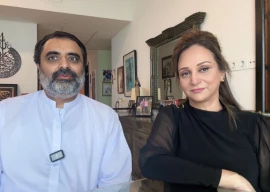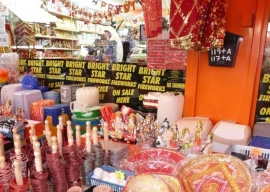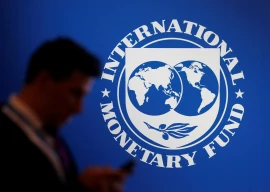
KARACHI:
A small, dingy room off Zaibunnisa street has little more to offer than just an opening to an alley strewn with heaps of garbage — but this is where painter Syed Qamarul Hassan works passionately from dawn to dusk. Truly gifted, Hassan knows how to sketch, using oil as well as water paints and make paper collage in addition to knowing how to work with pastels.
Hassan, who started to paint and sketch portraits of family members, who had passed away, as a tribute to them, began taking painting classes after migrating from Kanpur in India to Karachi. “When I was about 10 or 11 years old, I used to tag along with my maternal uncle and watch him paint the Karachi Tram. I used to wash his painting brushes,” says Hassan.
A conversation with Hassan along with two of his teachers — Seraj Ahmed and Adam Khan — brought to the fore the miserable state of art (and artists) in Pakistan. “Nobody values art here, it’s only in foreign countries that people appreciate it,” says Khan. To which Ahmed adds, “People are so unaware of art that when you sketch using pencil as the sole medium, they ask, ‘Would you colour it?’. These are the art lovers of our city.”
Further explaining why artists in the country are suffering, Khan adds, “Fraudulent people have entered the field just to make money out of this business of ours. They fetch paintings from here, tell us we are on contract for five years and sell our paintings abroad for thousands of dollars while we only get a measly amount.”
A dedicated painter
Hassan has a small room dedicated to portraits of world leaders ranging from Queen Elizabeth II (this was made just before Prince William got married) to a collage portrait of Benazir Bhutto. Additionally, there is also a sketch in pencil of Imam Khomeini. Hassan says, “When I exhibited this portrait at the Arts Council in 2004, people from Khana-e-Farang, Iran, also showed up and even bought one of my portraits.” He also recalls that once Fatima Suraiya Bajia turned up at one such exhibition and bought Anwar Maqsood’s painting.
The artist, who has had the honour of exhibiting his works at the Arts Council, Frere Hall and only recently, at Vision Art Gallery, says, “Painting, for me, is like a drug — I am addicted to it.”
“To pursue painting or any form of art, one should be passionate about it. However, today, artists are dying of hunger and most have vanished from Zaibunnisa street and Zainab Market which was once dotted with artists.” When asked why, he says, “There is no money in this business. Hence, many talented artists have moved to other professions.”
Meanwhile, another painter Islamuddin, an old man whose son is a faculty member at Napa, considers art his “daily diet”. Pre-partition, he was based in Rahwali, a village near New Delhi, India. As a child, Islamuddin started making charcoal portraits of Quaid-e-Azam Muhammad Ali Jinnah on the village walls but upon coming to Pakistan, he opted to work on cinema hoardings when Lollywood was at its peak in the 1960s.
When asked about what made this art form die, he replies sternly, “Digital Panaflex and a high rate of inflation.” At 77, Islamuddin frequently suffers from arthritis pain but he asserts, “Although, I can’t do leg work anymore, I can still do brush work.”
Published in The Express Tribune, December 27th, 2011.









































COMMENTS
Comments are moderated and generally will be posted if they are on-topic and not abusive.
For more information, please see our Comments FAQ